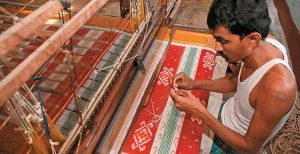
 By Vivek Pattanayak and Dr Sanjay Panda in Bhubaneswar, September 08, 2022: Importance of the unorganised sector in the socio-economic development of our country hardly needs any explanation. Spread over a wide range of economic activities like growing vegetables, flowers, fruits, weaving on handloom, and handicraft items, this segment forms a major plank of the economy, generating wealth and employment in the rural and semiurban areas. Inherent constraints typical to a developing country like India with high population and limited per capita resources makes it importance even more conspicuous.
By Vivek Pattanayak and Dr Sanjay Panda in Bhubaneswar, September 08, 2022: Importance of the unorganised sector in the socio-economic development of our country hardly needs any explanation. Spread over a wide range of economic activities like growing vegetables, flowers, fruits, weaving on handloom, and handicraft items, this segment forms a major plank of the economy, generating wealth and employment in the rural and semiurban areas. Inherent constraints typical to a developing country like India with high population and limited per capita resources makes it importance even more conspicuous.
Issues concerning the problems and prospects of the unorganised sector are of two broad types, some are common to all segments and others typical to a particular segment. Present write up seeks to deal with some of the common issues as well as those typical to the hand-loom sector in Odisha.
Several segments of the unorganised sector suffer as victims of disruptive technology. As the market requirements and customers’ preference change with the new technology, the unorganised sector struggle for its existence and coping up with the changed circumstances.
 Taking the case of hand-loom, it lost its monopoly in the clothing market with the arrival of power loom, as the labour component reduced substantially in mechanised weaving. Preference of the common man shifted in favour of the power loom due to inherent cost advantages and handloom kept on struggling in the competition with power loom products. Handloom weavers, who were respected for their excellent skill and higher earnings, got marginalised as an economically disadvantaged group. The case with other crafts has been similar.
Taking the case of hand-loom, it lost its monopoly in the clothing market with the arrival of power loom, as the labour component reduced substantially in mechanised weaving. Preference of the common man shifted in favour of the power loom due to inherent cost advantages and handloom kept on struggling in the competition with power loom products. Handloom weavers, who were respected for their excellent skill and higher earnings, got marginalised as an economically disadvantaged group. The case with other crafts has been similar.
Strength of the unorganised sector lies in its number which matters in a democracy, but it get eclipsed by the unorganised nature. In the prebudget discussion, budget speech and other forums unorganised sector draws lots of sympathy, but it remains short-lived. Apart from the budgetary provision, what really affects is the lack of understanding the real issues, apathy, adhocism and faulty designing and implementation.
The strategy for mobilising popular support for promotion of handloom by declaring 7th August, linked up with the freedom struggle, as the National Handloom Day in 2015 came as a far-sighted intervention of Hon’ble Prime Minister. Its annual celebration draws attention of the public and create enthusiasm among the weavers.
However, the challenge remains in sustaining it throughout the year. This year 2022 brought some surprises, with the enthusiastic district Collector of Baragarh issuing an appeal to the officers and staff of the district administration for wearing hand loom clothes on the 1st of August, the birthday of Guru S N Bahidar, an eminent personality of the district.
Similar action was taken by the Collector of Sambalpur and Jharsugusda districts. The new Secretary, Agriculture broadened this appeal to his department colleagues for wearing handloom clothes to office at least once in a week on Friday. These actions may be symbolic but need to be appreciated as it targets the key issue of marketing handloom products. Further, it is required to be institutionalized for production of quality clothes with new design in bulk and converting fabrics to readymade garments by involving enterprising youths.
Another fascinating change of relevance is the use of information technology based social media like WhatsApp, Face book along with service providers like Jio bringing the digital technology within the reach of common citizen. Restrictions on movement imposed due to Covid -19 during 2020-21 has converted this as a silent revolution. The common man, cutting across the urban-rural, rich -poor, education, age, and sex divides, has become tech savvy in using smart phone and social media.
 This period saw a quantum jump in digital transactions in the country by 51 per cent from 230 million (2019) to 346 million (2021) – higher than the population of USA. The handloom weavers are required to avail the benefits of this leapfrogging in digital technology for reaching out to the customers within and outside the country for getting customers’ preference, weaving products, and selling online, thereby bridging the geographical divide digitally.
This period saw a quantum jump in digital transactions in the country by 51 per cent from 230 million (2019) to 346 million (2021) – higher than the population of USA. The handloom weavers are required to avail the benefits of this leapfrogging in digital technology for reaching out to the customers within and outside the country for getting customers’ preference, weaving products, and selling online, thereby bridging the geographical divide digitally.
Several enterprising youths, particularly women, have geared up their Startups with zeal and passion like Utkalamrita. Their efforts for guiding the weavers in coming up with new products by synthesizing the tradition and culture base of handloom with the contemporary and future fashion trends with explanatory notes for meeting the emotional needs of the fashion loving elite customers has been noteworthy.
In a recent reference to promotion of yoga, a part of the great Indian culture abroad, Shri Jaishankar, India’s External Affairs minister stressed on the importance of Civil Society Organizations (CSO), as it cannot be done by the government alone. This applies to promotion of handloom, handicraft as well. Government needs to support all well-intentioned CSOs aimed at giving back to the society.
SHRADDHA, a CSO dedicated to empowering the handloom weaver’s setup in 1994 was geared up recently by a group of likeminded persons having interest and technical expertise guided by voluntary zeal. It has adopted a two-prong strategy based on (i) empowering the handloom weavers with confidence, training in dyeing and designing for quality production and (ii) encouraging entrepreneurs at weavers’ family as well as students of fashion, technology, science and art streams for scaling up quality production and marketing.
It seeks to forge collaboration with government as well as private organisations for supporting handloom and providing the last mile connectivity. In one such recent collaboration with the Visionspring Foundation, Shraddha organised eye screening facility for the weavers in the Nua Patna handloom cluster of Cuttack district. 1,008 handloom weavers were covered, out of whom 800 were provided eyeglasses at a nominal cost on the spot. The organisation has plans to organise training in dyeing, designing and making new products for the weavers as per the taste of the customers.
Handloom holds considerable promise for generating wealth and employment in the unorganised sector in the rural areas. This will make the growth inclusive and sustainable. However, this calls for a paradigm shift in the business model and marketing on digital technology based Direct to Customer (“D” to “C”) strategy. The key to success of this strategy lies in empowering the primary producer weavers with confidence, skill, and handholding. In this context, civil society organisations like SHRADDHA seeks to play a meaningful role.


Leave a Reply
Be the First to Comment!